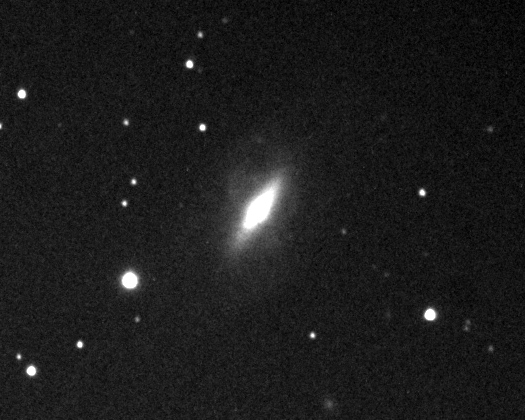
Cold Night of Imaging NGC2685 Polar-Ring Galaxy
Posted: 15 January 2013
I opened the observatory on Monday, 14 January 2013, at 1820 MST, 34°F. The sky was clear but there was a slight breeze blowing. At 1826 MST, viewed the moon, 77X. I then viewed Jupiter, 77X. Four moons were visible but seeing was very bad. I could barely make out the Great Red Spot nearing the central meridian. I returned to the moon, and as I was viewing the earthlit portion at 77X, a satellite transited the earthlit side of the moon. The satellite was moving in a north-to-south direction and was therefore a polar orbiting satellite. Neat!
At 1852 MST, due to the cold temperature (27°F) and the poor seeing, I decided to temporarily close the dome and return to the house while waiting for the moon to set.
The dome was re-opened at 2136 MST, temperature now at 21°F, as seen on the observatory thermometer:

I set up for prime focus imaging using the D7000 DSLR attached to the 8" LX200-ACF using the Off-Axis Guider (OAG). At 2150 MST, I did a focus test with the Bahtinov Mask on the star Pollux. I then slewed to NGC2685 and began searching for a suitable guide star. After spending several minutes of searching, no guide star was found. I rotated the OAG to change the orientation of the FOV and did another Pollux focus test with the Bahtinov Mask. This image clearly shows the infocus pattern from the mask:

Then back to NGC2685 and more searching for a guide star. At 2223 MST, after taking several framing test exposures (1 minute, ISO 6400) while trying to locate a good guide star, I finally got one. I elected to try it even though framing of the galaxy in the camera FOV was not very good. The guide star was faint and needed averted vision to keep it in sight in the illuminated reticle eyepiece. I did two 10 minute, ISO 6400, guided exposures. This is one of the images (full frame), with NGC2685 at the upper right. The polar ring is faintly visible.

I ended imaging at 2248 MST. I stacked the two images using Lynkeos, yielding an effective exposure of 20 minutes.

A portion of the "polar ring" of NGC2685 is faintly visible, oriented vertically. I had to stretch the "levels" during post-processing to show the ring. A difficult object to capture.
The observatory was closed at 2305 MST, 19°F.
Comments are welcome; use the Comments section below, or you can Email Me. Thanks.
Go to the previous report.
Return to the Cassiopeia Observatory Home Page.